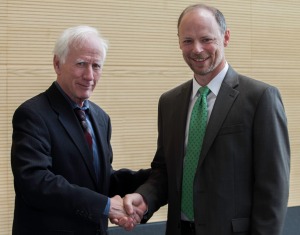Yesterday, Indiana University School of Medicine and the Regenstrief Institute held a ceremony establishing an endowed chair to honor Clement McDonald, M.D., a pioneer and innovator in the use of health information to improve patient care and outcomes.
Dr. McDonald, Distinguished Professor Emeritus and Regenstrief Professor Emeritus of Medical Informatics at the IU School of Medicine and former director of the Regenstrief Institute, is currently director of the National Library of Medicine’s Lister Hill Center for Biomedical Communications.
A distinguished clinician-researcher and one of the nation’s most accomplished experts in the field of electronic health record systems Dr. McDonald has inspired and trained scores of junior faculty and fellows at Regenstrief and IU. He developed the Regenstrief Medical Record System and for decades directed its use in clinical studies of innovations in medical informatics; many were conducted at Wishard-Eskenazi Health, one of the largest safety net public health care systems in the United States. This work has illuminated the ways in which electronic medical records can improve the quality and efficiency of patient care and its outcomes.

Clem McDonald and Bill Tierney present endowed chair to its first occupant, Titus Schleyer
Today the Regenstrief Medical Record System is one of the longest continually operational electronic medical record systems in existence. Dr. McDonald also created the Indiana Network for Patient Care for the largest and most comprehensive regional health information exchange in the country, involving more than 90 hospital systems in Indiana and more than 19,000 physicians.
Dr. McDonald is also an internationally recognized pioneer in the development of health data standards. He is the developer of Logical Observation Identifiers, Names, Codes, an identification system for tests and results that is a clinical data standard used across the nation and around the globe. A member of the Institute of Medicine, Dr. McDonald is a recipient of the President’s Medal for Excellence from IU, the highest honor an IU president can bestow.
I have the good fortune and high honor to have been named the first Clem McDonald Chair of Biomedical Informatics. It is hard to put into words what this means to me. The following is the text of my remarks at the ceremony:
“Dear collagues and friends,
Thank you very much for being here today. It means a lot to me.
So, what do you say when you are honored with the title ‘Clem McDonald Professorship of Biomedical Informatics?’ Well, my first reaction was to be speechless.
My second one was: ‘They must have made a mistake. They cannot possibly mean me.’ Eventually, I realized that they were serious about it and that is why we are all here today.
Of course, then the problem becomes to say something meaningful in response. So, this has become the shortest speech in my life about which I have deliberated for the longest time. I even wrote it down, which is something I never do.
To be honored with a named professorship is profoundly humbling. I consider this the most important achievement in my life to date. Actually, that is not quite correct. My most important achievement is having married my wife Alida. So, this is the most important achievement in my professional life.
Second, I see this honor not as much as a recognition for past accomplishments but a challenge for the future. In science, we are used to ‘standing on the shoulders of giants.’ The preceding remarks have driven home exactly what kind of giant Clem McDonald really is. So, the question becomes: How do we prove ourselves worthy of Clem’s legacy? The named professorship is not just an honor and challenge for me, it is one for all of us.
The Center for Biomedical Informatics is a storied institution with a rich history of accomplishments. That is good, but more is asked of us than to rest on our laurels.

Clem McDonald and Titus Schleyer
After I gave my Work in Progress presentation a few weeks ago, Tom Inui came up to me and introduced himself. It was the first time I met him. He asked me a simple question: ‘Why did Sam Regenstrief fail?’ I’m thinking: ‘Wow, here comes the real interview.’ So, I am wracking my brain, trying to remember Sam’s biography that I had read more than a year ago. So I say: ‘Sears wanted to diversify from more than one supplier for dishwashers.’ Tom shakes his head. ‘Somebody offered him the design of the first microwave to build, but he didn’t take it.’ Well, I am not sure how many of us would have chosen to build microwaves in an age when their widespread use was unimaginable! Tom shakes his head again. Then he says quietly: ‘He kept doing what he was always doing.’
At a fundamental level, Sam did not change his ways in a changed environment. It is a lesson that we would do well to heed.
Biomedical informatics operates in an environment radically different from what we had historically. Not anymore is informatics the domain of the few bright pioneers. Not anymore can it be content with producing stellar innovations confined to local settings. Not anymore does it exist in a vacuum.
No, informatics is now alive in the daily practice of healthcare. Its fruits are at work in every practice, hospital and health system. In short, it not only affects healthcare, it is healthcare.
That puts a particular burden on us. In keeping with Sam’s charge, we must ensure that informatics continues to improve healthcare.
I always like to joke that biomedical informatics is still in the Stone Age. Some people may scoff at that, but I think it is true. Many years ago, Paul David wrote in the American Economic Review:
‘Radically new technologies diffuse gradually, because it takes a long time for companies to learn how to use the new resources effectively. … Truly revolutionary applications often require major reorganizations of production, which may take a long time to discover.’ (P. David, The dynamo and the computer: A historical perspective on the modern productivity paradox, American Economic Review, 1990).
I think the same is true in healthcare. We have not even begun to discover how to use informatics to its full potential in healthcare.
Participating in and helping drive that discovery is one of our core responsibilities at CBMI. Sam Regenstrief charged us with improving healthcare. We have done that and will do it even better in the future.
But, I cannot do this alone. I need your help. In the process, we will have to work hard. We will need to do things in ways we haven’t done them before. We will need to reach out to others in unprecedented ways. But, most importantly, we will do it together.
In the process, one thing we will do is to honor Clem and his legacy. And, I can imagine few things as worthwhile as doing that.
So, I have been working here for four weeks and one day now. I’m sure many of you are asking yourself: ‘Well, what is Titus thinking? Does he like it here? Does he like us?’ I have to tell you: I love it here. Coming to work here was like coming home. I know that we can achieve great things together. I see it in your loyalty to the Institute. I see it in the ways you think, decide and act. I see it in your eyes. For me, the fact that we can do it means we will do it.
With that, let us raise our glasses to Clem: For what we owe to you and for what we will achieve in your honor.
Thank you very much.”
PS: Official press releases:
PPS: Recording (.wav file, 40 min.) of remarks at the ceremony by:
- Bill Tierney, President and CEO, Regenstrief Institute
- Charles Bantz, Chancellor, Indiana University-Purdue University Indianapolis
- Chris Callahan, Director, Indiana University Center for Aging Research
- Clem McDonald, Director, NLM Lister Hill National Center for Biomedical Communications
- Titus Schleyer, Director, Center for Biomedical Informatics, Regenstrief Institute



